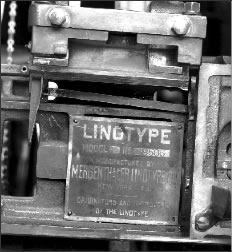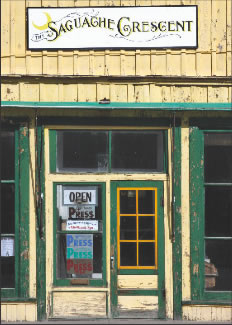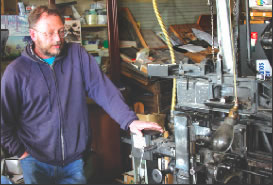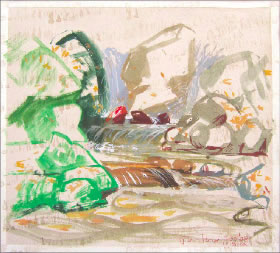In an era of newspaper closures and rapidly changing information delivery methods, it’s hard to imagine a news business continuing to employ early 1900s technology, yet still succeeding.
One such operation still exists in Central Colorado and it is one of a few remaining newspapers in the country to produce a print product using Linotype.

The Saguache Crescent, published weekly and owned by Dean Coombs was founded in 1875.
Today, with a local circulation of about 600, Coombs continues to create a four-page newspaper using a creaky, dust covered, antique hot metal machine.
The machine, a 1920s era Linotype, uses molten lead, which, once set, quickly cools to form a row of relief type. The rows of type are later locked together, inked and run through a press. Hot metal typesetting literally involves the injection of molten type metal into a mold that has the shape of one or more glyphs or writing elements.

Compared with today’s version of making a newspaper which is heavily dependent on computers, the Linotype process is laborious and time consuming.
Located in the mostly empty old Saguache business district, the dusty, cramped Crescent office building on Fourth Street seems right out of 1917 when current owner Dean Coombs’ grandparents, Charles and Mary Ogden, bought the newspaper.
They Ogdens had previously worked for the Blanca News, run The Moffat Times, and owned half of The Center Post-Dispatch – all San Luis Valley newspapers – before finally moving to Saguache and buying the Crescent.
After Charles died, Dean’s grandmother Mary and his mother, Marie, continued to run the paper along with two of her daughters. Dean’s father, Ivan Coombs, ended up helping out as well. Dean himself went to work for the newspaper when he was 12 and stayed on through high school.
After graduation he took a few years off to take classes at Adams State and moved around from Texas to California. In 1974 Coombs returned to Saguache to continue helping run the Crescent.

On December 26, 1978 his father passed away and Dean took over as publisher. He’s been at it ever since. His mother continued on as editor until 1999 after working the linotype machine for 60 years. She passed away in 2002.
At the heart of this antiquated news operation are the Linotype machines, the first, purchased new in 1921, and noisily running ever since. A more modern, 1940s model was later brought aboard to help create longer lines of type.
The typesetter (Dean) sits at the machine and, employing a proprietary 90-character keyboard, creates a lead-cast “slug” of reversed letters which are then hand-stacked in columns or “galleys.” The awkwardness of the setup has made Dean adept at reading text upside-down and backwards, a talent necessary to this operation.
Observing the machine in action is akin to watching a mechanized three-ring-circus – keystrokes translate into mechanical requests for molds which are filled with molten lead then travel along a conveyer where they are dropped, after cooling down, into a metal basket. Sounds of pulleys and belts collide with the tinkling of sliding metal and the tapping of keys. A person can’t help but wonder about the brilliant minds that created these machines, which, with enough persuasion, continue to function many years after they were first constructed. With the current dearth of Linotype repairmen, Dean does his own repairs, with much parts-scrounging and finger-crossing.

Along with metal engravings for advertising graphics plus the original Crescent flag from 1874, the galleys are locking into cast iron forms or “chases” in a flatbed printing press. The chases are then rolled with ink, a sheet of paper placed on top and run through a roller, transferring the ink onto the hand-fed sheets of newsprint. After allowing for dry-time, the stack of printed sheets is turned over and the backside is printed. The sheets are folded to make the final four-page broadsheet. Every week the process is repeated, leaving Dean little time for any other activities.
The paper’s bread and butter?are the county legals but the Crescent also publishes obituaries, events, travel stories written by locals, area artists’ profiles, announcements, classifieds and other newsworthy items.
Area schoolchildren often visit on field trips and visitors are welcome to stop and watch the elaborate process.
In the 1980s the newspaper?gained national publicity when it was featured on The CBS Evening News with two veteran newsmen, Dan Rather and Charles Kuralt.
To Dean’s knowledge there is only one other newspaper in Colorado using hot metal, The South YW Star in tiny Kirk. Located in Yuma County, the small, weekly news sheet was started in 2003 by Gene Thomas, a former editor and publisher of the Fruita, CO Times, using an Intertype machine which is similar to a Linotype. In fact, the Crescent may one of the only newspapers left in the entire country employing a Linotype machine, according to Michael J. Phillips, Editor and Publisher of The Printer, a monthly magazine for fans of the letterpress.
[InContentAdTwo]
In the past eight years, newspapers in Edinburg, Illinois, Sherburne, New York and Orange County, California have all succumbed to the lure of the digital age and retired their Linotype machines. The Messenger of Garfield in New Jersey discontinued their newspaper as of July 9 after 71 years of hot-lead publication, according to former editor Jim Huffman.
Even the last hot lead paper in Great Britain, The New Milton Advertiser and Lymington Times switched to offset printing several years back, according to Roy Greenslade of the UK Guardian News.
All this leaves the Saguache Crescent as the last of a breed, using historical methods to disseminate news, doggedly hanging on while the rest of the media world goes digital.


